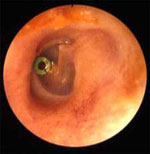What are grommets and why are they used?
Grommets are very small plastic tubes, which sit in a hole in the eardrum. They let air get in and out of the ear.

Some people get fluid behind the eardrum. This is sometimes called ‘glue ear'. It is very common in young children, but it can happen in adults too. We don't know exactly what causes glue ear.
Most young children will have glue ear at some time, but it doesn't always cause problems. We only need to treat it if it is causing problems with hearing or speech, or if it is causing lots of ear infections.
Grommets usually fall out by themselves as the eardrum grows. They may stay in for six months, or a year, or sometimes even longer. You may not notice when they drop out.
Does my child have to have grommets?
Glue ear tends to get better by itself, but this can take a while. We like to leave children alone for the first three months, because about half of them will get better in this time. After three months, we see the child again and decide whether we need to operate. If the glue ear is not causing any problems, we can just wait for it to settle by itself.
If glue ear is causing problems with poor hearing, poor speech or lots of infections, it may be better to put grommets in. If we do put in grommets, the glue ear may come back when the grommet falls out. This happens to one child out of every three who has grommets put in. We may need to put more grommets in to last until your child grows out of the problem.
You may change your mind about the operation at any time, and signing a consent form does not mean that your child has to have the operation. If you would like to have a second opinion about the treatment, you can ask your specialist. He or she will not mind arranging this for you. You may wish to ask your own GP to arrange a second opinion with another specialist.
What are the alternatives to grommets?
Some doctors may use nose drops or nasal sprays to see if they help. Steroid nasal sprays may help some children if they are able to use them.
Antibiotics and antihistamines do not seem to help this type of ear problem. Alternative treatments, such as cranial osteopathy do not seem to be helpful.
Taking out the adenoids may help the glue ear get better, and your surgeon may want to do this at the same time as putting grommets in.
A hearing aid can sometimes be used to treat the poor hearing and speech problems that are caused by glue ear. This would mean that your child would not need an operation.
Can I do anything to help my child?
Speak clearly, and wait for your child to answer. Make sure he or she can see your face when you speak. Call your child's name to get them to look at you before you speak. Let nursery and school teachers know that your child has a hearing problem. It may help for your child to sit at the front of the class.
After the operation
Grommets are not usually sore at all. You can give your child painkillers if you need to.
Grommets should improve your child's hearing straight away. Some children think everything sounds too loud until they get used to having normal hearing again. This usually takes only a few days.
Your child should usually be able to go back to school or nursery the day after the operation.
What about ear infections?
Most people with grommets do not get any ear infections. If you see yellow fluid coming out of the ear, it may be an infection. It will not be as sore as a normal infection, and your child won't be as ill. If you get some ear drops from your doctor, the problem will quickly settle. Some doctors may give antibiotics by mouth instead of antibiotic ear drops.
Can my child swim with grommets in?
Your child can start swimming a couple of weeks after the operation, as long as they don't dive under the water. You do not need to use earplugs - the hole in the grommet is too small to let water through. You do need to avoid getting dirty or soapy water into the ear, so in the bath or shower plug your child's ears with a cotton-wool ball covered in Vaseline.
What else should I know about grommets?
It is OK to fly in an aeroplane with grommets. The pain from the change in pressure in the aeroplane cannot happen when the grommets are working. We need to check your child's hearing after grommets have been put in, to make sure their hearing is better. Sometimes when a grommet comes out, a small hole is left behind. This usually heals up with time, and we rarely need to operate to close the hole. The grommet can leave some scarring in the eardrum. This does not affect the hearing.
By Peter Robb, Epsom & St Helier University Hospitals & Haytham Kubba, Royal Sick Children's Hospital Glasgow
Disclaimer
The details in this section are for general information only. Always check with your own surgeon.